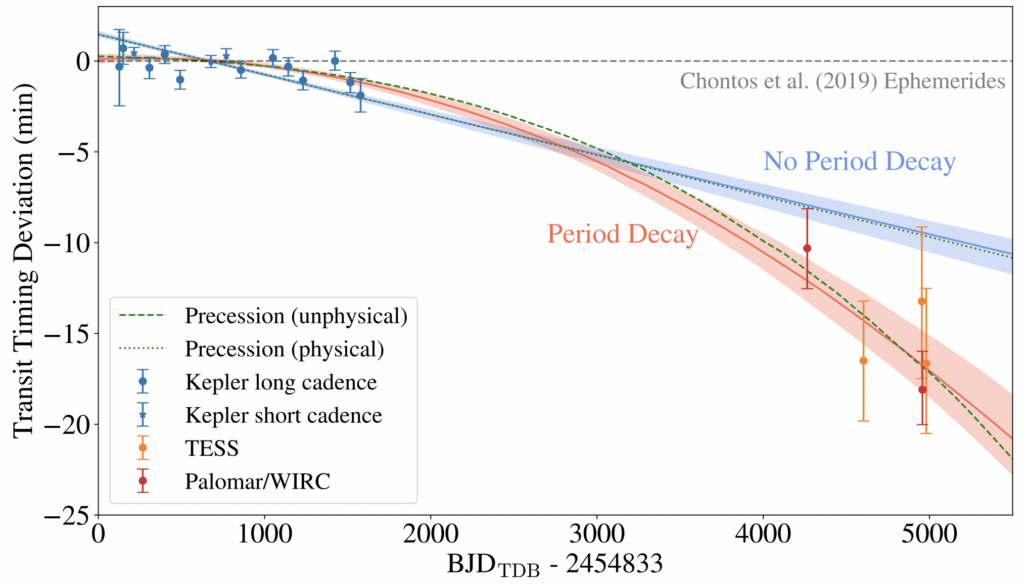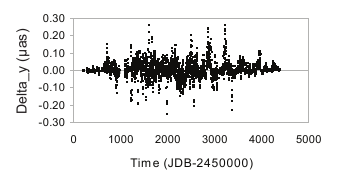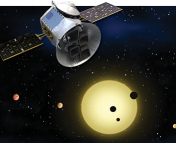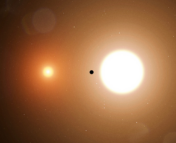Title: The Possible Demise of Kepler’s First Planetary System
Authors: Shreyas Vissapragada, Ashley Chontos, Michael Greklek-McKeon, Heather A. Knutson, Fei Dai, Jorge Pérez González, Sam Grunblatt, Daniel Huber, Nicholas Saunders
First author’s institution: Center for Astrophysics, Harvard & Smithsonian
Status: Published in the Astrophysical Journal [open access]
Introduction
It’s a truth universally acknowledged that all close-in planets will eventually experience death by their host star when the star evolves into a red giant. However, the demise of the exoplanet Kepler 1658b, will be induced by its own journey towards its star. The authors of today’s paper follow-up on Kepler’s first planet candidate, and find the rate at which the planet is spiraling inwards. Note that the end of this bite includes an explanation into the naming convention of Kepler systems if the reader is confused by the terms KIC, Kepler, and KOI.
Hello, my name is: Kepler 1658b
Kepler 1658b, or KOI 4.01, was Kepler’s first planet candidate; KOI 1.01, 2.01, and 3.01 were known prior to Kepler’s launch in 2009. The planet is roughly the size of Jupiter, but with six times its mass, 1.07 RJ and 5.88 MJ, respectively. The system was observed by Kepler during the four years of the mission, but at the time, astronomers did not find any evidence of the planet’s inward spiral.
Authors of today’s paper followed up on the planet with a ground based observatory, called Palomar, using the Wide-field Infrared Camera instrument, or WIRC, as well as data from the Transiting Exoplanet Survey Satellite, TESS. By adding data from WIRC and TESS, the authors were able to extend the original observational baseline of the system from 4 years to 13 years! This baseline extension is crucial since they want to study the dynamics of the planet over time. Figure 1 and 2 of the paper show transit light curves from the three telescopes.
Transit Timing Variations
The transit method has been extremely successful at discovering exoplanets; it takes advantage of a planet passing in front of the star along the line of sight of Earth, thereby decreasing the brightness of the star which is detectable by the Kepler telescope. If the planet was orbiting the star periodically, each transit would be separated by the same amount of time. For instance, another civilization would see Earth pass in front of the Sun every 365 days, but if the Earth was moving closer to the Sun at a constant rate of 3 days/year, the next time it would transit would be 363 days, then 360 days, then 357 days, and so on. The variation in the time that the planet transits is called transit timing variations.

In 2019, astronomers studied this system using 4 years of Kepler data. They found that the planet transits every 3.85 days (or ~0.05 AU), and found a negligible orbital decay rate consistent with zero. By extending the baseline, they looked for deviation in the transit times and found that after more than 2500 days, the transit deviated from the expected time by 10-15 mins (see Figure 1)! Extrapolating these data, they estimate that the planet will fall into its star in 2.5 million years.
Real or Not Real?
To confirm their findings, the authors did their due diligence by considering other possibilities to explain the data, in place of orbital decay. One possibility is line-of-sight acceleration where the system is accelerating towards Earth along our line-of-sight. However, if this were the case, the acceleration would show up as a linear trend in radial velocity data. Therefore, they included a parameter in their fit model assuming the presence of line-of-sight acceleration, but found its contribution to be negligible.
Another possibility is apsidal precession, where the entire system experiences a gradual rotation around the star, assuming an eccentric orbit (see Figure 2 for an animation). Again, they redo their fit assuming this possibility, and find a precession rate of 4 degrees per year, which is unrealistic. They considered many causes for this possible precession – if real – but the resulting model parameters were unphysical.
Domino Effect
If the reason for transit timing deviations is orbital decay, what causes the inward spiral? The authors suggest that the star undergoes so-called inertial wave dissipation. A typical star has an inner radiative zone, and an outer convective zone (read more details here). Gravity waves can be excited in the radiative zone, while inertial waves can be excited in the convective zone. For Kepler 1658, the authors suggest that dissipation of inertial waves in the convective zone results in loss of energy in the star.
Interestingly, the authors also found that the planet is over-luminous in the optical due to its own thermal emission which cannot be explained by reflected light from the star. Therefore, the planet is being superheated by another mechanism. The authors argue that 10% of the energy from the shrinking orbit is being lost and deposited in the planet causing it to superheat.
In short, the star and planet have a long-lasting effect on each other. First dynamical tides, due to gravitational forces between the two bodies, cause energy dissipation in the star. Then, this loss in energy causes the planet’s orbit to shrink. Finally, 10% of the energy from the shrinking orbit is lost, and deposited in the planet, superheating the planet to high temperatures.
What Next?
By using data from multiple surveys over 13 years, the authors found that planet Kepler 1658b is spiraling inward towards its star, with an inspiral timescale of 2.5 million years. The shrinking orbit can be explained by energy dissipation by inertial waves in the convective zone of the star. The authors encourage astronomers to continue observing this system, as observing more transits with data from JWST and TESS would further constrain their hypothesis, and also test the possibility of the precession model.
Side note: KIC, Kepler, KOI…oh my!
In stellar and exoplanet papers, it’s common to see the labels KIC, Kepler or KOI followed by numbers, which may all refer to the same system. However, the label indicates whether the star is a planet host, and if it is, then whether or not the planet has been confirmed. A KICID, or Kepler Input Catalog ID, is given to every star discovered by the Kepler space telescope. It is usually followed by a long integer number, such as KIC 3861595. If the star is considered to have transits in time-series data, then the planet is given the label KOI, or Kepler Object of Interest. However once a planet is confirmed, either through radial velocity or other methods, the star is given the label “Kepler” followed by a hyphen. So for the object in this paper, the star is called KIC 3861595. When astronomers saw transits in the data, the planet candidate was given the label KOI 4.01. Once the planet was confirmed, the star was re-labeled Kepler 1658. The associated planet is called Kepler 1658b, where the letter refers to the order in which the planet was discovered.
Astrobite edited by: Konstantin Gerbig
Featured image credit: Gabriel Perez Diaz/Instituto de Astrofísica de Canarias




